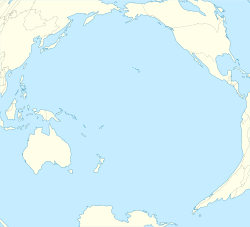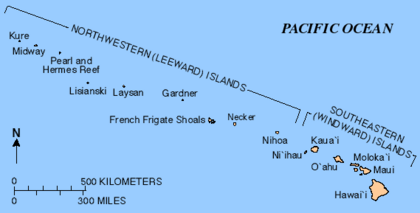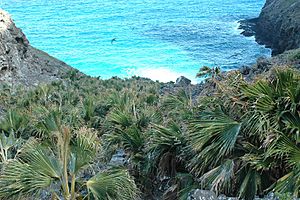Nihoa facts for kids
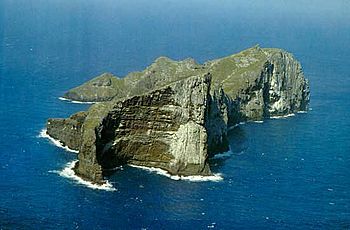 |
|
| Geography | |
|---|---|
| Location | Papahānaumokuākea Marine National Monument |
| Coordinates | 23°03′38″N 161°55′19″W / 23.06056°N 161.92194°W |
| Archipelago | Northwestern Hawaiian Islands |
| Area | 0.69 km2 (0.27 sq mi) |
| Administration | |
|
United States
|
|
| Demographics | |
| Demonym | Nihoan |
| Population | 0 |
Nihoa ( Hawaiian: Nīhoa), also known as Bird Island or Moku Manu, is the tallest of ten islands in the Northwestern Hawaiian Islands (NWHI). These islands are not inhabited by people. Nihoa is found at the southern end of the NWHI chain. It is about 296 kilometers (184 miles) southeast of Necker Island.
Nihoa is the closest NWHI island to the main Hawaiian Islands. It is about 240 kilometers (149 miles) northwest of Kauaʻi. The island has two main peaks. Miller's Peak in the west is 272 meters (892 feet) tall. Tanager Peak in the east is 259 meters (850 feet) tall. Nihoa covers about 0.69 square kilometers (171 acres). It is surrounded by a large coral reef that spans 575 square kilometers (142,000 acres). The island's rough shape looks like a tooth. This is why it is called Nīhoa, which means "tooth" in Hawaiian.
The island is home to 25 types of plants and many animals. This makes it the most diverse island in the entire NWHI. Some birds, like the Nihoa finch and Nihoa millerbird, live only on Nihoa. Unique plants, such as Pritchardia remota and Schiedea verticillata, are also found only here. One plant, Amaranthus brownii, was thought to be the rarest. It has not been seen since 1983 and is now believed to be extinct.
The plants and rocky areas provide homes for 18 types of seabirds. These include red-footed boobies and brown noddies. Terns, shearwaters, and petrels also nest here. Old evidence shows that Native Hawaiians lived on or visited Nihoa around the year 1000 AD. Over time, people mostly forgot where Nihoa was. Only old stories kept its name alive. Captain James Colnett found the island again in 1788. Queen Kaʻahumanu visited it in 1822. Later, King Kamehameha IV made it part of the Kingdom of Hawaii.
In 1909, Nihoa became part of the Hawaiian Islands Reservation. This was a federal wildlife refuge started by U.S. president Theodore Roosevelt. The Tanager Expedition explored the island in 1923. They made a full list of its many species. In 1940, Nihoa became part of the Northwestern Hawaiian Islands Wildlife Refuge. In 1988, it was added to the National Register of Historic Places. This was because of its important old cultural sites. In 2006, it became part of the Papahānaumokuākea Marine National Monument.
Scientists are working to protect endangered plants. They want to grow them in other places so they don't disappear. People who want to visit Nihoa for research need a special permit. This helps stop new plants or animals from being brought to the island. New species could harm Nihoa's delicate ecosystem.
Contents
Island Formation and Features
Nihoa is part of the Hawaiian–Emperor seamount chain. This chain includes volcanic islands, atolls, and underwater mountains. It stretches from the island of Hawaiʻi to the Aleutian Islands. Nihoa is the youngest of the ten islands in the uninhabited Northwestern Hawaiian Islands. It formed about 7.2 million years ago. The oldest island, Kure Atoll, formed 30 million years ago.
Over millions of years, Nihoa has worn away a lot due to erosion. Nihoa is one of only four islands in the NWHI that still has exposed rock from its volcanic past. Six valleys run from the north to the south side of the island. They all meet at the south side. These valleys are West Valley, West Palm Valley, Miller Valley, Middle Valley, East Palm Valley, and East Valley.
These valleys slope down towards Adam's Bay on the south side. There are also sea caves in this area.
Some interesting features on Nihoa include Dog's Head Peak. It is 109 meters (358 feet) tall and looks like a dog's head. Pinnacle Peak is 191 meters (626 feet) tall. It is a volcanic dike. This means it is a wall of harder rock that was left behind after softer rock around it wore away. The only flat area on the island is Albatross Plateau. It is just below Miller's Peak.
The Devil's Slide is a narrow crack in the land. It drops 213 meters (700 feet) down. It starts from Albatross Plateau and goes north. It ends at steep cliffs that drop 58 meters (190 feet) straight into the ocean. Rare ferns grow in this deep crack. Also, several unique species live here, including a giant cricket.
The island is about 1371 meters (4,500 feet) long from east to west. It is between 274 and 914 meters (900-3,000 feet) wide. Its overall shape is like half of a saddle. One side has very steep cliffs, and the other slopes down towards the ocean. The highest points are Miller Peak at 277 meters (909 feet) and Tanager Peak at 260 meters (853 feet).
Island Ecology and Unique Species
Nihoa is hard to reach and does not have many guano (bird droppings) deposits. This made the island less appealing to humans in the past. This helped protect its unique species from dying out. Because Nihoa is small, most of its unique animals and plants are endangered. A single disaster, like a big fire or new invasive species, could wipe out the whole population.
One such invasive species is the gray bird grasshopper. Between 1999 and 2003, these grasshoppers ate a lot of the plants on the island. This was a big threat to Nihoa's plant life. The next year, the number of grasshoppers went down, and the plants grew back healthy. The grasshoppers likely came to Nihoa carried by wind from Kauai.
The cliffs on the north side of the island are mostly bare. But the sloping valleys are covered with different grasses and shrubs. The two most common grasses on these slopes are Eragrostis variabilis and Panicum torridum. There are also various shrubs and bushes on the island slopes. These include Chenopodium sandwicheum and ilima bushes (Sida fallax).
Unique species found only on Nihoa include:
- Pritchardia remota fan palm, which is the only tree on the island.
- The Nihoa millerbird.
- The Nihoa finch.
- The Nihoa conehead katydid.
- The Nihoa carnation.
- Sesbania tomentosa.
- The amaranth Amaranthus brownii.
- The trapdoor spider Nihoa mahina.
- Thaumatogryllus conanti, a giant cricket found in the Devil's Slide area.
- Plagithmysus nihoae, a longhorned beetle.
- Eupelmus nihoaensis, a wasp.
- Hylaeus perkinsian, Perkin's yellow-faced bee.
Important Bird Area
Nihoa is part of the Northwest Hawaiian Islands Important Bird Area (IBA). This area is recognized by BirdLife International. It is important because of its many seabirds and landbirds that live only there.
Ancient Hawaiian History
|
Nihoa Island Archeological District
|
|
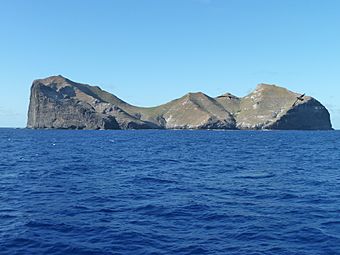
View of Nihoa Island
|
|
| Lua error in Module:Location_map at line 420: attempt to index field 'wikibase' (a nil value). | |
| Nearest city | Kauai, Hawaii |
|---|---|
| NRHP reference No. | 88000640 |
| Added to NRHP | June 13, 1988 |
Nihoa was well known to the early Hawaiians. Scientists have found many old agricultural terraces and house sites. At least one site dates back to around 867–1037 AD. It is not clear how many people lived on Nihoa. The large terraces suggest many people, but there is not much fresh water on the island.
Archaeologists think that the island could support about 100 people. If the island had more forests in the past, it would have had more fresh water. Some also believe that Nihoa might have been used only for religious reasons. This would mean ancient Hawaiians visited it sometimes but did not live there for long. Because of its importance, Nihoa was added to the National Register of Historic Places in 1988. It later became part of Papahānaumokuākea Marine National Monument in June 2006.
Nihoa, along with Necker Island, is one of the most northern, isolated, smallest, and driest Hawaiian islands. It gets very little dust or volcanic ash. These factors likely led to the island losing its forests in the past. This might be why the ancient Hawaiian population on Nihoa disappeared. A similar event happened on Easter Island, where people faced problems after their environment changed.
Artifacts found from past human life on the island include:
- Stone terraces
- Upright stones
- Carved stone bowls (one was taken by a Hawaiian Queen in the 19th century)
- Stone tools
- Cave shelters
- Heiau (ancient Hawaiian temples)
The terraces are thought to have been used for farming. Many useful items like stone tools and bowls have been found. However, some scholars now think the island might have been used more for religious ceremonies. This is because of the large number of Heiau found there.
Early Exploration and Royal Visits
The first European to find Nihoa was Captain James Colnett. He saw the island on March 21, 1788, while on his ship, the Prince of Wales. For a long time, people thought Captain William Douglas discovered it. He saw Nihoa almost a year later. This was because Colnett was away from England for a long time. He was even held prisoner by the Spanish.
The old settlements found by early explorers led to Nihoa and Necker islands being called the 'mystery islands'.
By the late 1700s, most Hawaiians had forgotten about Nihoa. In 1822, Queen Kaʻahumanu and her husband King Kaumualiʻi sailed with Captain William Sumner to find Nihoa. Their generation only knew about the island from songs and myths. Later, King Kamehameha IV sailed there to officially make the island part of the Kingdom of Hawaiʻi.
In 1885, Princess Liliuokalani made a special trip to Nihoa. Her lunch was cut short when someone accidentally started a wildfire. The group tried to leave the island, but the rising tide made it hard. Several boats got flooded, and some photos they took were ruined. During this visit, a carved stone bowl was found. The Queen took it back to the main islands.
In 1859, the exact location of Nihoa island was mapped by the survey ship, USS Fenimore Cooper.
The Tanager Expedition
From 1923 to 1924, the Tanager Expedition was an important scientific trip to Nihoa island. This trip led to many discoveries in biology and archaeology.
The Tanager Expedition carried out the first archaeological study of the island. They found proof of an ancient settlement on Nihoa. This included platforms, terraces, and human remains.
Important discoveries during this expedition included finding a sample of Amaranthus brownii. They also discovered the Nihoa millerbird, which was officially named Acrocephalus familiaris kingi.
During this trip, scientists counted several hundred Loulu fan palms on the island. They also noted twenty other types of flowering plants.
Examples of the exploration work done:
- Mapping the island
- Studying bird life
- Cataloging plants
- Collecting insects
- Researching marine life
- Studying the island's geology
On the Tanager Expedition, they also found what was left of a modern fishing camp in a cave near the landing area. It had old coats and bags of rice.
See also
 In Spanish: Nihoa para niños
In Spanish: Nihoa para niños


